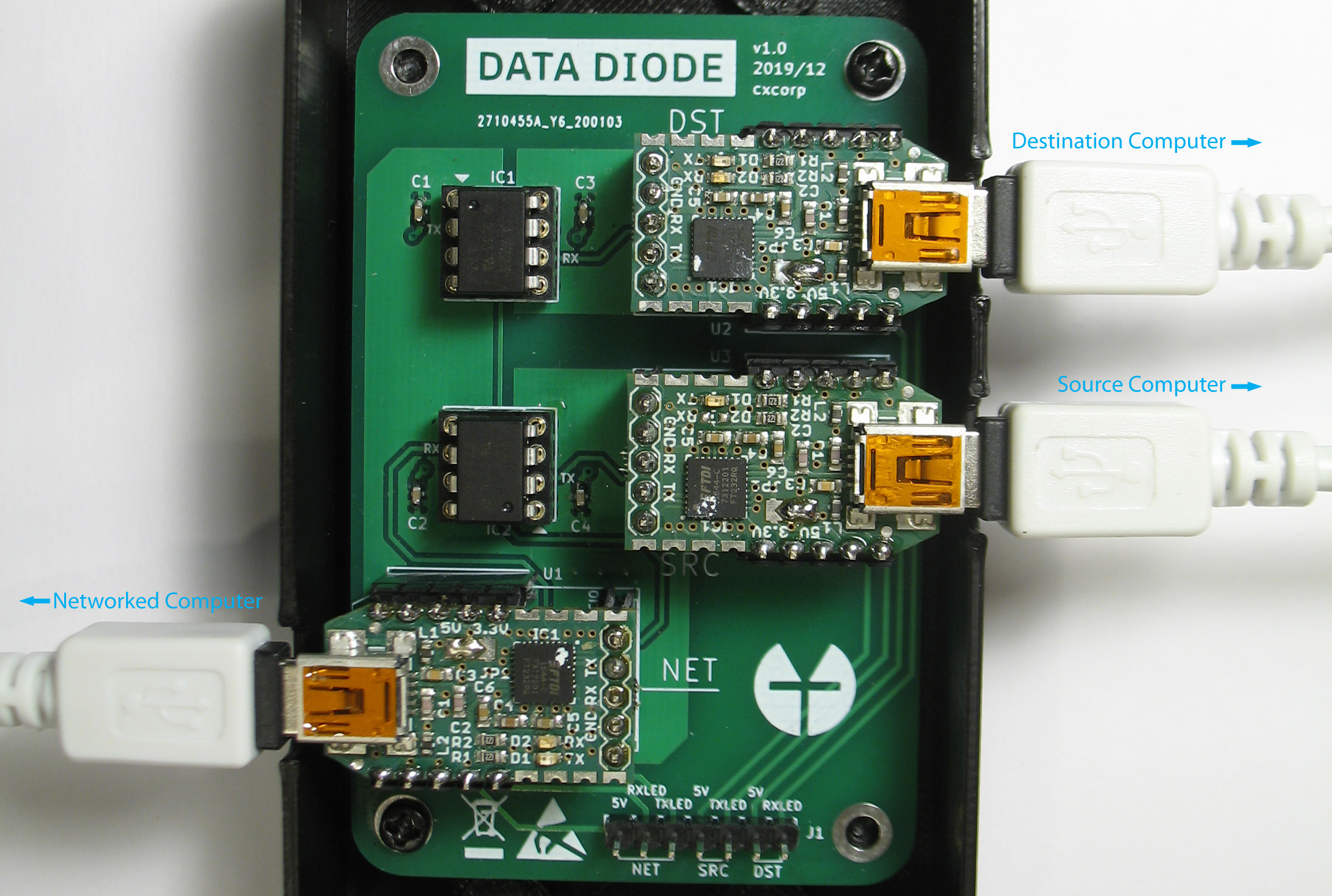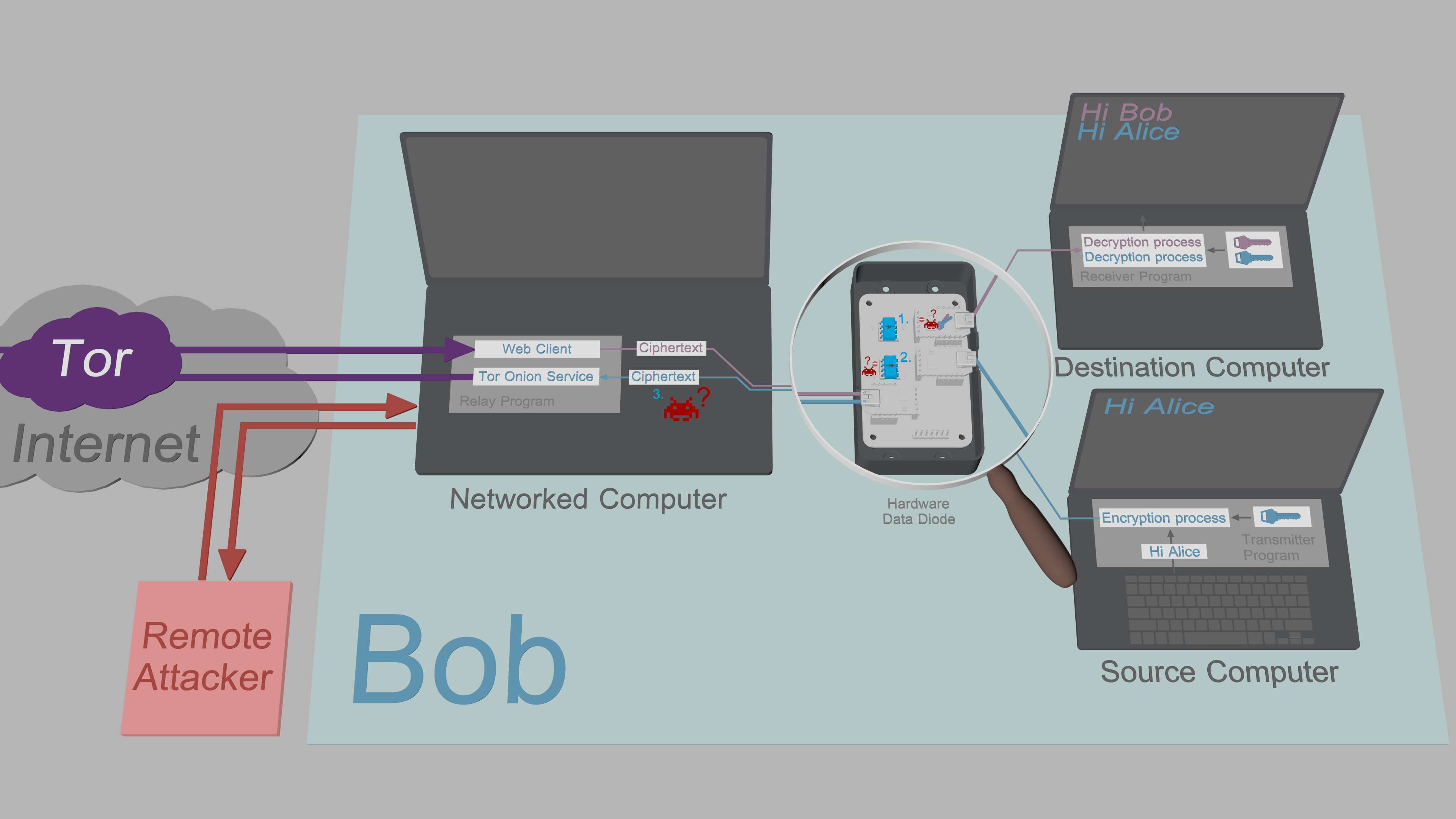
tfc
采用硬件隔离的端对端加密通信系统
Tinfoil Chat (TFC) 是一款开源的端对端加密通信系统,采用硬件级数据单向传输防止远程密钥窃取。TFC通过Tor网络匿名传输数据,使用先进加密技术保护通信内容。系统采用三台计算机架构,将加密和解密过程隔离,并通过物理单向数据二极管连接,有效阻止黑客攻击和数据泄露,提供高度端点安全保障。
Tinfoil Chat
Tinfoil Chat (TFC) is a FOSS+FHD peer-to-peer messaging system that relies on high assurance hardware architecture to protect users from passive collection, MITM attacks and most importantly, remote key exfiltration. TFC is designed for people with one of the most complex threat models: organized crime groups and nation state hackers who bypass end-to-end encryption of traditional secure messaging apps by hacking the endpoint.
State-of-the-art cryptography
TFC uses XChaCha20-Poly1305 end-to-end encryption with deniable authentication to protect all messages and files sent to individual recipients and groups. The symmetric keys are either pre-shared, or exchanged using X448, the base-10 fingerprints of which are verified via an out-of-band channel. TFC provides per-message forward secrecy with BLAKE2b based hash ratchet. All persistent user data is encrypted locally using XChaCha20-Poly1305, the key of which is derived from password and salt using Argon2id, the parameters of which are automatically tuned according to best practices. Key generation of TFC relies on Linux kernel's getrandom(), a syscall for its ChaCha20 based CSPRNG.
Anonymous by design
TFC routes all communication exclusively through the Tor anonymity network. It uses the next generation (v3) Tor Onion Services to enable P2P communication that never exits the Tor network. This makes it hard for the users to accidentally deanonymize themselves. It also means that unlike (de)centralized messengers, there's no third party server with access to user metadata such as who is talking to whom, when, and how much. The network architecture means TFC runs exclusively on the user's devices. There are no ads or tracking, and it collects no data whatsoever about the user. All data is always encrypted with keys the user controls, and the databases never leave the user's device.
Using Onion Services also means no account registration is needed. During the first launch
TFC generates a random TFC account (an Onion Service address) for the user, e.g.
4sci35xrhp2d45gbm3qpta7ogfedonuw2mucmc36jxemucd7fmgzj3ad. By knowing this TFC account,
anyone can send the user a contact request and talk to them without ever learning their
real life identity, IP-address, or geolocation. Protected geolocation makes physical
attacks very difficult because the attacker doesn't know where the device is located on
the planet. At the same time it makes the communication censorship resistant: Blocking TFC
requires blocking Tor categorically, nation-wide.
TFC also features a traffic masking mode that hides the type, quantity, and schedule of communication, even if the network facing device of the user is hacked. To provide even further metadata protection from hackers, the Internet-facing part of TFC can be run on Tails, a privacy and anonymity focused operating system that contains no personal files of the user (which makes it hard to deduce to whom the endpoint belongs to), and that provides additional layers of protection for their anonymity.
First messaging system with endpoint security
TFC is designed to be used in hardware configuration that provides strong endpoint security. This configuration uses three computers per endpoint: Encryption and decryption processes are separated from each other onto two isolated computers, the Source Computer, and the Destination Computer. These two devices are dedicated for TFC. This split TCB interacts with the network via the user's daily computer, called the Networked Computer.
In TFC data moves from the Source Computer to the Networked Computer, and from the Networked Computer to the Destination Computer, unidirectionally. The unidirectionality of data flow is enforced, as the data is passed from one device to another only through a free hardware design data diode, that is connected to the three computers using one USB-cable per device. The Source and Destination Computers are not connected to the Internet, or to any device other than the data diode.
Optical repeater inside the optocouplers of the data diode enforce direction of data transmission with the fundamental laws of physics. This protection is so strong, the certified implementations of data diodes are typically found in critical infrastructure protection and government networks where the classification level of data varies between systems. A data diode might e.g. allow access to a nuclear power plant's safety system readings, while at the same time preventing attackers from exploiting these critical systems. An alternative use case is to allow importing data from less secure systems to ones that contain classified documents that must be protected from exfiltration.
In TFC the hardware data diode ensures that neither of the TCB-halves can be accessed bidirectionally. Since the protection relies on physical limitations of the hardware's capabilities, no piece of malware, not even a zero-day exploit can bypass the security provided by the data diode.
How it works
With the hardware in place, all that's left for the users to do is launch the device specific TFC program on each computer.
In the illustration above, Alice enters messages and commands to Transmitter Program running on her Source Computer. The Transmitter Program encrypts and signs plaintext data and relays the ciphertexts from Source Computer to her Networked Computer through the data diode.
Relay Program on Alice's Networked Computer relays commands and copies of outgoing messages to her Destination Computer via the data diode. Receiver Program on Alice's Destination Computer authenticates, decrypts and processes the received message/command.
Alice's Relay Program shares messages and files to Bob over a Tor Onion Service. The web client of Bob's Relay Program fetches the ciphertext from Alice's Onion Service and forwards it to his Destination Computer through his data diode. Bob's Receiver Program then authenticates, decrypts and processes the received message/file.
When Bob responds, he will type his message to the Transmitter Program on his Source Computer, and after a mirrored process, Alice reads the message from the Receiver Program on her Destination Computer. All this happens seamlessly and automatically.
Why keys and plaintexts cannot be exfiltrated
The architecture described above simultaneously utilizes both the classical and the alternative data diode models to enable bidirectional communication between two users, while at the same time providing hardware enforced endpoint security:
-
The Destination Computer uses the classical data diode model. This means it can receive data from the insecure Networked Computer, but is unable to send data back to the Networked Computer. The Receiver Program is designed to function under these constraints. However, even though the program authenticates and validates all incoming data, it is not ruled out malware couldn't still infiltrate the Destination Computer. In the event that would happen, the malware would be unable to exfiltrate sensitive keys or plaintexts back to the Networked Computer, as the data diode prevents all outbound traffic.
-
The Source Computer uses the alternative data diode model. This means it can output encrypted data to the insecure Networked Computer without having to worry about being compromised. The data diode lacks the hardware that would allow transmission of data to the Source Computer, which protects the Source Computer from all remote attacks. The Transmitter Program is also designed to work under the data flow constraints introduced by the data diode; To allow key exchanges, the short elliptic-curve public keys are input manually by the user.
-
The Networked Computer is designed under the assumption it can be compromised by a remote attacker: All sensitive data that passes through the Relay Program is protected by authenticated encryption with no exceptions. Since the attacker is unable to exfiltrate decryption keys from the Source or Destination Computer, the ciphertexts obtained from Networked Computer are of no value to the attacker.
Qubes-isolated intermediate solution
For some users the APTs of the modern world are not part of the threat model, and for others, the requirement of having to build the data diode by themselves is a deal-breaker. Yet, for all of them, storing private keys on a networked device is still a security risk.
To meet these users' needs, TFC can also be run in three dedicated Qubes virtual machines. With the Qubes configuration, the isolation is provided by the Xen hypervisor, and the unidirectionality of data flow between the VMs is enforced with Qubes' qrexec framework. This intermediate isolation mechanism runs on a single computer which means no hardware data diode is needed.
Supported Operating Systems
Source/Destination Computer
- Debian 12.5
- PureOS 10.3
- *buntu 24.04 LTS
- Pop!_OS 22.04 LTS
- Linux Mint 21.3
- LMDE 6
- Zorin OS 17.1
- Qubes 4.2.1 (Debian 12 VM)
Networked Computer
- Tails 6.2
- Debian 12.5
- PureOS 10.3
- *buntu 24.04 LTS
- Pop!_OS 22.04 LTS
- Linux Mint 21.3
- LMDE 6
- Zorin OS 17.1
- Qubes 4.2.1 (Debian 12 VM)
More information
Threat model<br> FAQ<br> Security design<br>
Hardware Data Diode<Br> Breadboard version (Easy)<br> Perfboard version (Intermediate)<br> PCB version (Advanced)<br>
How to use<br> Installation<br> Master password setup<br> Local key setup<br> Onion Service setup<br> X448 key exchange<br> Pre-shared keys<br> Commands<br>
[Update
编辑推荐精选


Vora
免费创建高清无水印Sora视频
Vora是一个免费创建高清无水印Sora视频的AI工具


Refly.AI
最适合小白的AI自动化工作流平台
无需编码,轻松生成可复用、可变现的AI自动化工作流


酷表ChatExcel
大模型驱动的Excel数据处理工具
基于大模型交互的表格处理系统,允许用户通过对话方式完成数据整理和可视化分析。系统采用机器学习算法解析用户指令,自动执行排序、公式计算和数据透视等操作,支持多种文件格式导入导出。数据处理响应速度保持在0.8秒以内,支持超过100万行数据的即时分析。


TRAE编程
AI辅助编程,代码自动修复
Trae是一种自适应的集成开发环境(IDE),通过自动化和多元协作改变开发流程。利用Trae,团队能够更快速、精确地编写和部署代码,从而提高编程效率和项目交付速度。Trae具备上下文感知和代码自动完成功能,是提升开发效率的理想工具。


AIWritePaper论文写作
AI论文写作指导平台
AIWritePaper论文写作是一站式AI论文写作辅助工具,简化了选题、文献检索至论文撰写的整个过程。通过简单设定,平台可快速生成高质量论文大纲和全文,配合图表、参考文献等一应俱全,同时提供开题报告和答辩PPT等增值服务,保障数据安全,有效提升写作效率和论文质量。


博思AIPPT
AI一键生成PPT,就用博思AIPPT!
博思AIPPT,新一代的AI生成PPT平台,支持智能生成PPT、AI美化PPT、文本&链接生成PPT、导入Word/PDF/Markdown文档生成PPT等,内置海量精美PPT模板,涵盖商务、教育、科技等不同风格,同时针对每个页面提供多种版式,一键自适应切换,完美适配各种办公场景�。


潮际好麦
AI赋能电商视觉革命,一站式智能商拍平台
潮际好麦深耕服装行业,是国内AI试衣效果最好的软件。使用先进AIGC能力为电商卖家批量提供优质的、低成本的商拍图。合作品牌有Shein、Lazada、安踏、百丽等65个国内外头部品牌,以及国内10万+淘宝、天猫、京东等主流平台的品牌商家,为卖家节省将近85%的出图成本,提升约3倍出图效率,让品牌能够快速上架。


iTerms
企业专属的AI法律顾问
iTerms是法大大集团旗下法律子品牌,基于最先进的大语言模型(LLM)、专业的法律知识库和强大的智能体架构,帮助企业扫清合规障碍,筑牢风控防线,成为您企业专属的AI法律顾问。


SimilarWeb流量提升
稳定高效的流量提升解决方案,助力品牌曝光
稳定高效的流量提升解决方案,助力品牌曝光


Sora2视频免费生成
最新版Sora2模型免费使用,一键生成无水印视频
最新版Sora2模型免费使用,一键生成无水印视频
推荐工具精选
AI云服务特惠
懂AI专属折扣关注微信公众号
最新AI工具、AI资讯
独家AI资源、AI项目落地

微信扫一扫关注公众号










